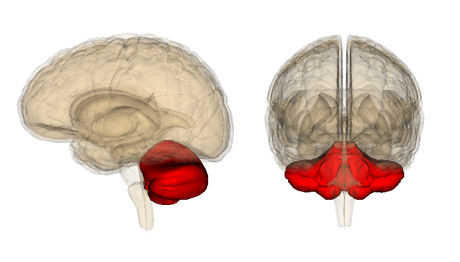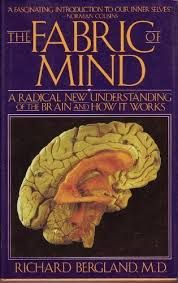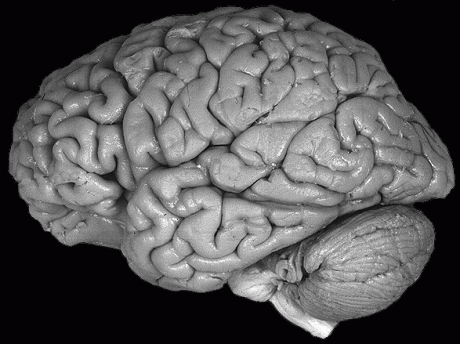Intelligence
Is Cerebellum Size Linked to Human Intelligence?
Evolutionary changes to cerebellum size may be linked to human intelligence.
Posted October 14, 2014

Cerebellum in red.
In 1504, Leonardo da Vinci made wax castings of the brain and coined the term “cerebellum” which is Latin for “little brain.” My father, Richard Bergland M.D., was a neuroscientist and neurosurgeon who was obsessed with the cerebellum. He passed this obsession on to me as an athlete and writer.
Over the past decade, I have been researching the cerebellum. My mission is to identify daily habits and lifestyle choices that can optimize the structure, function, and connectivity of both hemispheres of the cerebellum to other brain regions. In doing so, I believe that every person can achieve his or her personal best throughout a lifespan. The cerebellum is the prime moving force of The Athlete's Way.
The cerebellum is responsible for the coordination of fine-tuned muscle movements, balance, proprioception... It is essential for procedural learning, implicit memory and much, much more.
Your cerebellum makes it possible for you to move your muscles automatically at an unconscious level when you do things like ride a bike, drive a car, hit a tennis ball, play the piano... The cerebellum may also be involved in cognitive function and linked to human intelligence.

Purkinje Cells of the Cerebellum
As a young tennis player, my father was my coach. He made it clear to me from an early age that the cerebellum was the seat of muscle memory and taught me that through "practice, practice, practice" I could permanently hammer and forge my tennis strokes into the muscle memory held in the Purkinje cells of the cerebellum.
My father also believed that the cerebellum was doing much more than he and his colleagues were able to prove empirically in the laboratory.
The cerebellum is only 10% of brain volume but holds over 50% of your brain’s total neurons. Based on this fact, my father would always say, “Whatever the cerebellum is doing, it’s doing a lot of it.”
My dad had a hunch that the cerebellum worked closely with the cerebrum and was involved with cognitive function. In the 20th century, the medical establishment considered the idea that the cerebellum had anything to do with "cerebral thinking" a radical and far-fetched notion.
When my father published the Fabric of Mind (Viking) in the 1980s, he insisted on showing a sagittal view of the brain so that readers could clearly see the salient divide between the cerebrum and the cerebellum on the cover.

My father was working at Harvard Medical School when he wrote The Fabric of Mind. It would have been career suicide to publish theoretical ideas about the cerebellum without empirical scientific data to back them up. At the time that he was doing neuroscientific research, the brain imaging technology didn’t exist to prove that the cerebellum was involved in cognitive function.
In 2005, when I got a book deal with St. Martin’s Press to write The Athlete’s Way, my father strongly encouraged me to push the envelope and use my platform to say things about the cerebellum from an athlete's perspective that he couldn't say as a scientist.
When I was writing the manuscript for The Athlete’s Way I spoke with my father every day about the neuroscience in my book. Together we created a new split-brain model that shifted the focus from left brain-right brain to what I coined “up brain-down brain.”
Over the past decade, I've had my antennae up for any new research about the cerebellum. I am on a mission to share the latest research about the cerebellum with a general audience in honor of my dad who passed away in 2007. It’s been exciting in recent years to see a wide range of studies confirm my father’s hypotheses.
In 2014, there is a growing consensus among neuroscientists that the cerebellum plays an important role in higher-level cognitive abilities.
"Whatever the Cerebellum Is Doing, It's Doing a Lot of It."

In October 2014, anthropologists from the United Kingdom reported that evolutionary rate comparisons show that the cerebellum expanded up to six times faster than anticipated throughout the evolution of great apes, including humans. The researchers believe that the size of our frontal lobes alone can’t account for humans' superior cognitive abilities.
The UK researchers said that although the neocortex of the brain has been called, "the crowning achievement of evolution and the biological substrate of human mental prowess," their findings suggest that the cerebellum may be of equal importance for the technical, linguistic, and social evolution of the human brain.
The study, “Rapid Evolution of the Cerebellum in Humans and Other Great Apes,” was published in the Cell Press journal Current Biology. This study has the potential to radically change existing perceptions of human brain evolution.
Using a method for detecting evolutionary rate changes along the branches of phylogenetic trees, the researchers found that the cerebellum underwent rapid size increases and expanded significantly faster than had been predicted by changes in neocortex size.

Lead author of the study, Robert Barton of Durham University, said in a press release, "Our results highlight a previously unappreciated role of the cerebellum in ape and human brain evolution that has the potential to refocus researchers' thinking about how and why the brains in these species have become distinct and to shift attention away from an almost exclusive focus on the neocortex as the seat of our humanity."
Co-author of the study, Chris Venditti of the University of Reading, added, “The cerebellum had been seen primarily as a brain region involved in movement control, and more recent evidence has begun to suggest that the cerebellum has a broader range of functions. The cerebellum also contains an intriguingly large number of densely packed neurons.”
Richard Barton echoed the words of my father when he said, "In humans, the cerebellum contains about 70 billion neurons -- four times more than in the neocortex, Nobody really knows what all these neurons are for, but they must be doing something important."
Barton and Venditti say that the cerebellum seems to be particularly involved in the temporal organization of complex behavioral sequences, such as those involved in making and using tools. Interestingly, evidence is now emerging that the cerebellum plays a critical role in language, too.
Gray Matter Volume in the Cerebellum Supports Cognition As We Age
A 2011 study found that the brain volume of gray matter in the cerebellum supports the function of the frontal lobes which are vulnerable to the neurodegenerative effects of aging. The researchers found a correlation between cerebellar brain volume and cognitive function in older adults.
In a press release, lead author of the study, Dr. Michael Hogan, said , "General intelligence is correlated with many basic aspects of information processing efficiency which I believe depend upon the functioning of the cerebellum, including the speed and consistency of our perceptions and decisions, and the speed with which we learn new skills. This is exciting research, as it suggests that there may be a backdoor route into maintaining higher cortical functions in old age, that is, through the sustained activation of cerebellar networks via novel sensory-motor and cognitive activities, all of which I believe the cerebellum seeks to regulate and automate, working in concert with the cortex."
Conclusion:The Cerebellum Could Take Center Stage in 21st Century Neuroscience
Sam Wang, at The Wang laboratory at Princeton University, is doing fascinating research on information processing in the cerebellum, including: its contributions to motor learning, the cerebellar roles in cognitive and affective function, and autism spectrum disorder.
Wang and his colleagues at Princeton recently discovered that early cerebellum malfunction hinders neural development and could be a possible root of autism. In August 2014, they published this new theory in the journal Neuron.
While the cerebellum remains mysterious, Barton and Venditti conclude that the cerebellum is "a new frontier for investigations into the neural basis of advanced cognitive abilities." Please stay tuned to my blog posts and upcoming book for all the latest research on the cerebellum.
If you'd like to read more on the cerebellum and Purkinje cells, check out my Psychology Today blog posts:
- "Primitive Brain Area Linked to Human Intelligence"
- "Toward a New Split-Brain Model: Up Brain-Down Brain"
- "Neuroscientists Discover How Practice Makes Perfect"
- "How Is the Cerebellum Linked to Autism Spectrum Disorders?"
- “Childhood Family Problems Can Stunt Brain Development”
- "The Neuroscience of Calming a Baby"
- “Why Is Dancing So Good For Your Brain?”
- “The Neuroscience of Madonna’s Enduring Success”
- "Gesturing Engages All Four Brain Hemispheres"
- "The Neuroscience of Superfluidity"
- "One More Reason to Unplug Your Television"
- "Better Motor Skills Linked to Higher Academic Scores"
- "Hand-Eye Coordination Improves Cognitive and Social Skills"
- "The Neuroscience of Imagination"
- "Too Much Crystallized Knowledge Lowers Fluid Intelligence"
- "No. 1 Reason Practice Makes Perfect"
Follow me on Twitter @ckbergland for updates on The Athlete’s Way blog posts.




